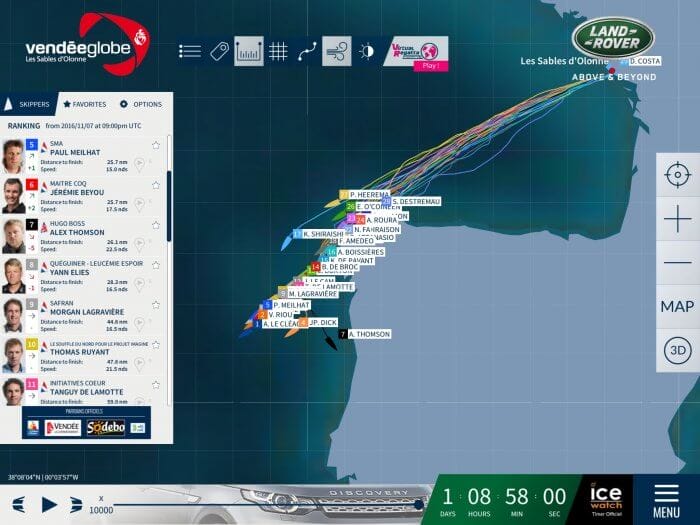
The Vendee Globe started last week. For the next three months or so I will be following the race every day, as I did four years ago, and four years before that.
And this from a guy who has exactly zero interest in being a sports spectator…no, not even hockey, my adopted country’s favourite. As for baseball and cricket, they put me into a coma. Even watching “the beautiful game” is a total snore to me.
But there’s just something about the Vendee Globe that reels me in.
Maybe it’s because I think that completing a Vendee Globe, never mind winning it, is the toughest challenge that any person can take on in any sport or discipline. Yea, tougher than Everest, tougher than man-hauling a sled to the North Pole…well, maybe that comes close…if you do it alone and unsupported.
By the way, the Vendee iPad app is a great way to follow along.
Cutless Bearings
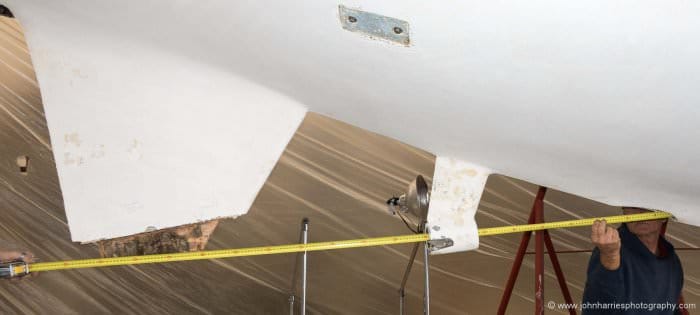
I do this a lot these days: When I need measurements, instead of taking them and writing it down, I get a couple of people to hold a tape and I take a photo.
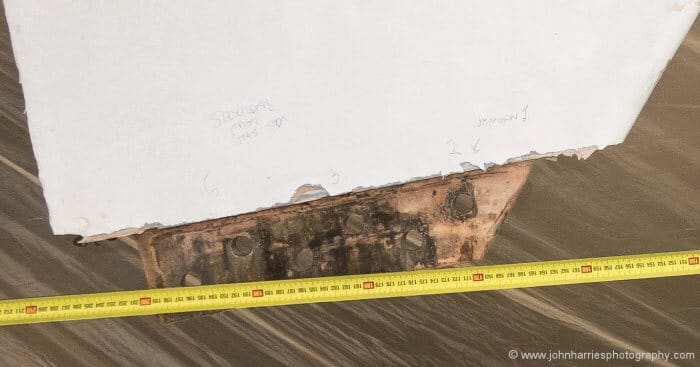
You can do this with a phone, but it works even better with a higher res camera. This came from my Sony RX-100 Mk4 and is a crop of the one above, quite legible down to 1mm on my screen.
Now, if I had just had them hold the tape the right way up, I would be really smart.
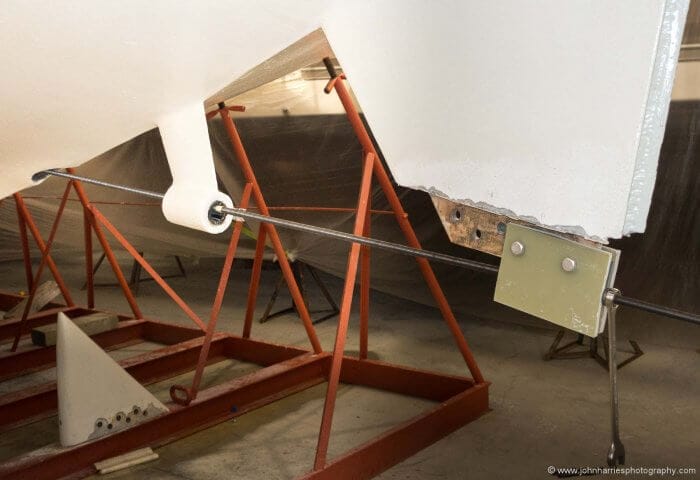
I needed the measurements to build this cutless bearing extraction tool. There’s a disk of 1/2″ G10 on the inside end (up inside the stern tube) of the 5/8″ fine thread rod. Just wind on the wrench and out she comes…except it didn’t work, much to my amazement.
Tightened as much as I dared…no movement. Think about how much load that is! I’m sure the engineers around here could calculate it, but I suspect the answer is one $%#@!! of a lot.
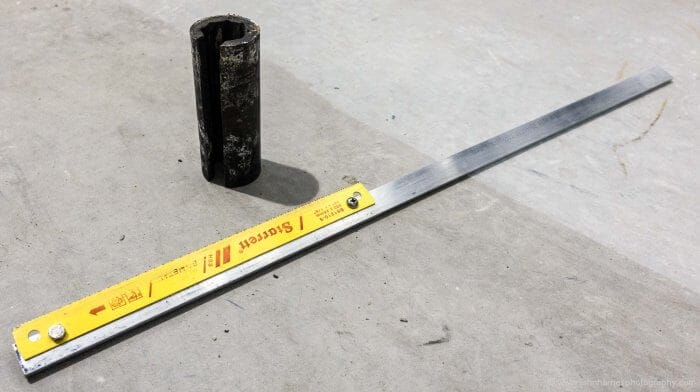
Back to the drawing board to design and build this tool. The long handle required because the bearing had managed to wind itself way up inside the shaft log—that’s a story for another day.
Nearly burst a blood vessel putting two cuts in the bearing at full reach. But then it just dropped out—go figure. If it was easy, everybody would be doing it.
Prime Lenses
Those of you who hate it when I go off topic should stop reading now. Not to worry, this post is in addition to our normal content, so you are not missing out.
Still here? Cool.
A couple of years ago I sold both my prime (no zoom) lenses. One because it was a bad example of a good design—happens in boats and lenses—and the other because it focused slowly on my OMD-EM1.
And generally I have been pretty happy with three fast 2.8 zooms covering 24 mm to waaay out to 420 mm. But every so often I get a serious jones on for a fast prime…or maybe two—there is simply no way to get “that special look”, particularly in people photography, other than a fast prime.
Yesterday I had to drive to Halifax. By the time I finished my errands it was rush hour. So what could I do but go and visit my pusher…er, favourite camera photo store, while the traffic died down. Cue the eye roll from Phyllis.
So I spent a happy hour, at least it was happy for me, making the sales people open boxes…lots of boxes…while I tried out lenses on my Olympus body.
I shot all wide open and used the long-suffering sales staff as models. This is not a lens review…I do have a life. But I thought the different looks that focal lengths produce would be of interest…well, I’m interested anyway.
Let’s start wide. The numbers in brackets are 35 mm equivalent. Click on the images to see them bigger.
None of this is great art, or scientific, and the light in the store is for shit, but still…
I like the 17 mm (34) Oly for environmental portraits and the 45 mm (90) Oly for emphasizing the person over everything else. I expected to like the Leica/Panasonic 15 mm, but turns out it’s just a bit wide for me, and the 25 mm (50) Oly did not grab me, although I thought it would. Maybe I should try it again…cut to shot of camera sales people screaming and running for the hills.
The Pany 20 mm is really nice, but like its predecessor, which I owned and loved, it focuses slow on my Oly body, so that’s out.
To me a test like this is a heck of a lot more useful than spending hours on the forums and reviews reading tech specs. Bottom line, a lens must give you images that please you, and that pleasure can’t be completely quantified—bit like boats.
So what did I buy? Nothing…yet.
What about you? What focal length(s) just work for you?
Let’s finish with the obligatory oversaturated evening shot. This one of Mahone Bay. Shot at 1/4-second hand held—just amazing what modern in-body image stabilization can do and Oly are the masters at it.


Hi John,
I was wondering if the Sony RX-100 MK4 would be a suitable camera on a boat. Is is weatherproof enough to be outside while sailing, obviously not getting dunked in the water, but can it take the splashes and rain? It looks like a great portable camera with great resolution.
On a side note, winter is finally settling in here out here in the Bragg Creek and Canmore. We should be skiing full time here in a few weeks. Let me know if you are planing a trip out here 🙂
Cheers,
Bill
Hi Bill,
No, the sony is not weather proofed at all. I would expect it to do fine with a little mist and maybe a short time in light rain, but any sort of salt water splash would probably do for it. That said, Sony do sell a full on waterproof housing for it.
Canmore sounds great! Unfortunately, we will not be coming that way this year, hopefully next winter.
John
I shot the Oly 45 f1.8 on Pany GX7 body in a small town in the mountains of Costa Rica with a very dim incandescent bulb illuminating my partner’s favorite carnival activity, BUMPER CARS! The look of glee in her eyes and cheeks was very crisp as she bashed her way around the floor
( TWICE)!
Seasons Greetings
Hi Pedr,
A perfect use for that lens I think. The GX7 looks like a really nice camera too.
The new Oly 25 1.2 in intriguing – flies in the face of the small/light prime concept – but it is fast and super sharp.
Hi Kristen,
I agree, what a lens! I’m hearing it rivals the best from Lica and Zeiss. Still, price would be a bit rich for me for a lens I probably would not use that often…well that’s my story now.
John, was that MC’s cutlass bearing you were replacing? What’s the story behind what appears to be a detachable rudder?
Hi Marc,
Yup, our bearings. And, like many boats, the rudder and the bottom of the skeg must come off to get the prop shaft out. Luckily the builder did some really smart stuff and we have great access, so two of us can have the rudder off in about two hours.
If the rudder is aluminum like the rest of the boat, I would be interested to know how top half fastens to the bottom half, and whether bushings are involved. Metal boat owners have an interest in such details! It’s a nice feature to have, however; our rudder’s transom-hung, so off she comes in under half an hour!
Hi Marc,
Wow, that would be a whole post and would require photos.
It might be worth it given how often rudders sustain damage. Ours is well-supported by a skeg, but most these days are not…presumably yours represents both the middle ground (no pun intended) not only in terms of making shaft work easier, but by way of repair, should damage be sustained. If you chose to, you could probably carry the lower half of that rudder as a bolt-on spare.
Hi Marc,
Colin has already written extensively and well on rudders: https://www.morganscloud.com/2013/07/09/spade-rudders-ready-for-sea/
Concerning the Vendée Globe, have a look to the virtual regatta and consider joining. You will have a boat and you will need to select your route, your sails, etc. You have real time information (wind, waves, pressure, etc) and there is a spectacular 3D view showing your boat in various angles. Amaizing.
Hi Jean,
I’m sure it would be fun. That said, running this site already has me spending a huge amount of time in front of a computer screen, so I think I will pass.
I switched to a full frame Sony about a year and a half ago. My favorite lenses were a 35 year old OM Zuiko 50mm f1.8 and an old Canon EF-85/1.2L, both with adapters. The Sony gear was stolen in San Francisco last summer, and I switched to shooting primarily B&W film. An old OM-1n w/50mm when my primary purpose is taking photos, and an almost equally old XA w/35mm f2.8 rangefinder that is always in my pocket. I think the prime lens selection is based on what I’m shooting. 28mm iphone for landscapes, 35 mm rangefinder for street and urban, 50mm for nature and things, 85mm for portraits. A scan through tens of thousands of shots in Lightroom grouped by focal length from when I was using a zoom seems to support that. The lens I will probably pick up next will be a 50mm macro for those flowers and close up “small world” shots. Of course it’s all subjective!
Hi Dave,
Great to hear from you again, but what a bummer about the stolen gear! Thanks for the interesting thoughts on focal length. It really is fascinating to look though our photo libraries and see what focal lengths seem to work for us. For me, a lot of my best stuff is long, but then quite a few of my favourite shots are around 40mm. Anyway, instructive.
Yes, that 40mm focal length has a lot of appeal. If I understand correctly, on a full frame 35mm format, 42mm focal length is equal to the diagonal of the frame, and some call it a “perfect” prime. Apparently it is easier to make a very sharp lens in that configuration. It is also nicely in the middle between 35 which many say is similar to our typical field of veiw (or attention) and 50 which is similar to many paintings. That 20mm Lumix has been on my list for a long time. Though I don’t have a m43 camera myself, Janna has a Lumix GH3 that I get to play with occasionally.
Cutlass Bearing question – you mention that it had worked it’s way up the shaft log – i have a cutlass bearing in the strut, but none in the log – and i experience some shaft whip at higher RPM’s, maybe because there is no bearing between the strut and engine. – what is your experience for common practice? Do most boats have bearings in both strut and the log? I can put one in, but the opening on the hull end is very small (just over shaft size) and flush with the outside of the hull. Or would i be better off with a pillow bearing inside between the shaft log an the engine? It’s a 2nd hand boat for me, all Aluminum, with no access to the original designer or building plans to reference. MCYachts BlueOcean 42.
Thanks,
Tom & Ingrid
S/V Moin
Hi Tom,
As a general rule, you should try not to ever overconstrain anything and 3 radial bearings on a shaft (the first being your transmission one) is generally considered an overconstraint. It works when you have a very flexible shaft but if your shaft is properly designed with appropriate stiffness, then 2 bearings fully defines that shaft. A 3rd bearing would necessarily put a bend in the shaft even with a very good alignment and as the shaft rotates, this would mean that the shaft would have to keep flexing. The end result from this resistance and the associated heat is usually bearing or shaft failure.
The proper way to fix shaft whip is to look at the reasons for it. Things I would look at are: balance of prop, shaft straightness, alignment, number of prop blades, prop overhang, shaft diameter. Our boat had a minor shaft whip problem which we cured by switching from a 2 to 3 blade prop but we could have also upped the shaft size although that would have been a lot harder. Other owners of the same model have reported issues with props with long overhangs and 2 bladed props.
Eric
Hi Eric,
That’s interesting and logical. However, after my recent problem I had a very experienced marine engineer who is also a Lloyds Surveyor have a look, as I was hoping to do just as you suggest and dispense with the bearing in the log. Particularly since the shaft is 1.5″ Aquamet only 5.75′ long from aft face of coupling to front face of strut bearing and I’m only putting 87hp at max shaft RPM of 1090 through it.
He came back after running the numbers through an industry standard permissible unsupported shaft calculator and said categorically that I required the third bearing in the log.
In addition Jim McCurdy, who designed the boat, specified the third bearing on the plans.
So, I guess I will go with that, particularly since all has been good for 30 years and over 15,000 engine hours.
That said, my gut sympathies are with your position, since, as you point out, perfect three bearing alignment would be near impossible.
Hi John,
In your application, it obviously works (although concerning that it moved axially) and you shouldn’t change something that works. I believe that there are a few key differences in your application compared to many boats that allow it to work. For one, I suspect you have a very carefully set of machined bores for the bearings to go in which is something that very few yards are really setup to do. Also, you have a boat with sufficient stiffness to make this work, many boats would flex too much and cause significant issues. In general, boats are more tolerant of multiple bearings than other applications as the bearings used tend to have play allowing an imperfect alignment to not cause large bending loads.
To be honest, I am not that surprised that you needed a third bearing, 1.5″ is not that heavy of a shaft when there is a big prop hanging off of it.
Eric
Hi Eric,
Thanks for the confirmation. All makes sense to me, particularly the point about boat stiffness.
Hi Tom,
See my comment on my own issues for some thoughts. That said, I would not add a bearing if the designer had not specified one. As Erik says there are a lot of reasons for shaft whip and if one of those things is at the root of the problem, adding a bearing could, I think, make things worse.
Eric, would you be willing to discuss directly (e-mail or phone), I’d love to give you more install details & symptoms, and hear some pros/cons about my considered next steps, but don’t want to bore the group here. (I can post the final results when cured).
John, if you’ve got professional resources who you think would be helpful, that’d be appreciated as well.
Thanks,
Tom
Hi Tom,
To solve this problem, you are going to need someone locally who can actually look at your boat. Where are you? I know a few places that might help.
You may also need to remove the shaft so that it can be checked properly for any bends. Therefore neither Eric, or my contact here in Nova Scotia, will be able to add much.
Also Eric shares a huge amount of his expertise here in the comments without any compensation but I’m not comfortable with Eric being asked to provide one on one consulting. My own experience with going down that road in past years indicates that if he took that on he would either have to give up his day job and starve…or give up sleeping.
Thanks John,
I’m in the Annapolis area, but i’m a die-hard DIY owner, so haven’t reached out yet other than to seek advice and explore options like I’ve done here. I understand and agree with your comment on Eric’s time – I didn’t know if this discussion was his line of work, and if so, I’d compensate him appropriately for his advice/time.
Tom
Hi Tom,
Thanks for your understanding on that. I hear you on DIY, I’m the same, but some things really do benefit from a pro looking at them, and this may be one of those. I don’t know anyone in Annapolis, but if you are ever down east my friends at Billings Deisel and Marine will sort it for sure, albeit at a price.
(Disclosure: Billings is a long time corporate member and supporter of this site and the staff and owners are personal friends.)
Hi Again Tom,
Another way to approach this (kind of DIY) is to pull the shaft and take it to a really good machinist who specializes in making shafts (not a boat yard) and have them check the shaft and the coupling, as well as the prop and how it mates to the shaft taper. To do this right you need experience and special gear, but this approach will cost you a lot less than going to a mechanic or a full service boat yard, and is also a lot more likely to find the problem.
While you have the gear at the machine shop, get them to face the coupling while on the shaft.
Hi Tom,
As John has nicely stated, I don’t do one on one consulting. I enjoy participating in this website as it is very informative, civilized and tends to have very knowledgeable and thoughtful people commenting in addition to the expertise in the writing. My day job is as a mechanical engineer developing robotic systems although I used to do air compressors and steam expanders. This means that I have designed tons of shafts and know good design practices for them but occasionally I will have an issue and then am forced to call the true experts in this who are far more knowledgeable than I on things like vibration, balance, etc.
John has given you a good idea of where you should start your search with a good machinist. Good luck.
Eric
Hi John!
How do you determine when is the time to check / replace cutlass bearing?
Is there a way to check this if the boat is in the water in the slip?
The PO of my 30 year old aluminum boat did replaced it 5 years ago…
I’m planning to hull out this year to replace thru holes, so thinking what else should I put on my list, as hull out here in Amsterdam is not the cheapest thing to do.
Hi Taras,
If there is any movement at all when you grab the prop boss and push it hard back and forth, then replace the cutlas bearing, if not, don’t worry about it. Under typical yacht use a cutlass bearing lasts for a very long time.
Thank you!
Would you carry a cutlass bearing as a spare part if going on for circumnavigation?
Absolutely, in fact we carry two spares at all times.
You can lean more about the spares we carry here: https://www.morganscloud.com/2015/02/18/parts-inventory/